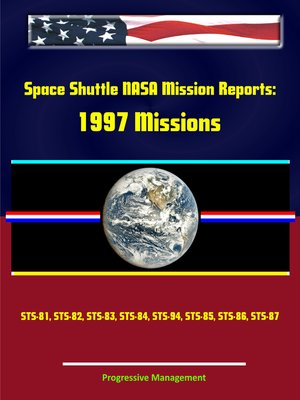Space Shuttle NASA Mission Reports
ebook ∣ 1997 Missions, STS-81, STS-82, STS-83, STS-84, STS-94, STS-85, STS-86, STS-87
By Progressive Management

Sign up to save your library
With an OverDrive account, you can save your favorite libraries for at-a-glance information about availability. Find out more about OverDrive accounts.
Find this title in Libby, the library reading app by OverDrive.



Search for a digital library with this title
Title found at these libraries:
| Library Name | Distance |
|---|---|
| Loading... |
These official final program mission reports issued by the NASA Johnson Space Center cover missions in 1997: STS-81, STS-82, STS-83, STS-84, STS-94, STS-85, STS-86, and STS-87. In these thorough reports, with information and specifics not available on NASA website mission descriptions, each orbiter system is reviewed in detail along with technical information on performance and anomalies.STS-81: The primary objectives of this flight were to perform the fifth rendezvous and docking with the Russian Mir Space Station and perform a logistics resupply and the exchange of a Mir Astronaut. A double Spacehab module carried science experiments and hardware (including the Biorack facility consisting of two incubators, a glovebox, and two refrigerators as well as a refrigerator/freezer), the Space Acceleration Measurements System (SAMS), Risk Mitigation Experiments (RMEs) and Russian logistics in support of the Phase 1 Program requirements.STS-82: The primary objectives of the STS-82 flight were to perform the operations necessary to fulfill the second on-orbit servicing requirements for the HST. The servicing tasks included installation of the Near Infrared Camera and Multi-Object Spectrometer (NICMOS), installation of the Space Telescope Imaging Spectrograph (STIS), replacement of the Data Interface Unit (DIU) 2 as well as the Engineering/Science Tape Recorder (ESTR)-2.STS-83: The primary objective of the STS-83 flight was to successfully perform the planned operations of the First Microgravity Science Laboratory (MSL-1).STS-84: The primary objective of the STS-84 flight was to rendezvous and dock with the Mir Space Station, and perform the exchange of a Mir astronaut. A double Spacehab module and the crew compartment carried science experiments including Protein Crystal Growth - Single Locker Thermal Enclosure System (PCG-STES); Liquid Motion Experiment (LME) hardware; Risk Mitigation Experiments (RME's) including the Cosmic Radiation Effect and Activation Monitor (CREAM), Electrolysis Performance Improvement Concept Study Experiment (EPICS), and the Radiation Monitoring Experiment -III (RME-III); and Russian logistics in support of the Phase 1 Program requirements.STS-94: The primary objective of the STS-94 flight was to successfully perform the planned operations of the First Microgravity Science Laboratory (MSL-1).STS-85: The primary objective of the STS-85 flight were to successfully accomplish science objectives by operating the Cryogenic Infrared Spectrometers and Telescopes for the Atmosphere-Shuttle Pallet Satellite (CRISTA-SPAS), to launch and operate in orbit a Manipulator Flight Demonstration (MFD), and to perform operations on the Technology Applications and Science (TAS-01).STS-86: The primary objectives of the STS-86 flight were to rendezvous and dock with the Mir Space Station, and perform the exchange of a Mir astronaut.STS-87: The primary objectives of the STS-87 flight were to successfully perform the operations necessary to fulfill the requirements of the United States Microgravity Payload -4 (USMP-4) and SPARTAN-201.







